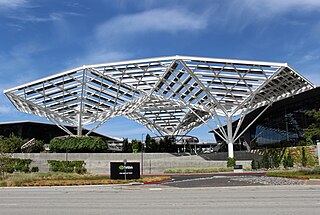
Nvidia Corporation is an American multinational corporation and technology company headquartered in Santa Clara, California, and incorporated in Delaware. It is a software and fabless company which designs and supplies graphics processing units (GPUs), application programming interfaces (APIs) for data science and high-performance computing, as well as system on a chip units (SoCs) for the mobile computing and automotive market. Nvidia is also a dominant supplier of artificial intelligence (AI) hardware and software.

A graphics processing unit (GPU) is a specialized electronic circuit initially designed to accelerate computer graphics and image processing. After their initial design, GPUs were found to be useful for non-graphic calculations involving embarrassingly parallel problems due to their parallel structure. Other non-graphical uses include the training of neural networks and cryptocurrency mining.
General-purpose computing on graphics processing units is the use of a graphics processing unit (GPU), which typically handles computation only for computer graphics, to perform computation in applications traditionally handled by the central processing unit (CPU). The use of multiple video cards in one computer, or large numbers of graphics chips, further parallelizes the already parallel nature of graphics processing.
A physics processing unit (PPU) is a dedicated microprocessor designed to handle the calculations of physics, especially in the physics engine of video games. It is an example of hardware acceleration.

Diggnation was a weekly humor video podcast hosted by Kevin Rose and Alex Albrecht. Broadcast on Revision3, the first episode aired on July 1, 2005 and the last episode on December 30, 2011.
The Brook programming language and its implementation BrookGPU were early and influential attempts to enable general-purpose computing on graphics processing units. Brook, developed at Stanford University graphics group, was a compiler and runtime implementation of a stream programming language targeting modern, highly parallel GPUs such as those found on ATI or Nvidia graphics cards.

Ray-tracing hardware is special-purpose computer hardware designed for accelerating ray tracing calculations.
CoreAVC was a proprietary codec for decoding the H.264/MPEG-4 AVC video format.

Compute Unified Device Architecture (CUDA) is a proprietary parallel computing platform and application programming interface (API) that allows software to use certain types of graphics processing units (GPUs) for accelerated general-purpose processing, an approach called general-purpose computing on GPUs (GPGPU). CUDA API and its runtime: The CUDA API is an extension of the C programming language that adds the ability to specify thread-level parallelism in C and also to specify GPU device specific operations (like moving data between the CPU and the GPU). CUDA is a software layer that gives direct access to the GPU's virtual instruction set and parallel computational elements for the execution of compute kernels. In addition to drivers and runtime kernels, the CUDA platform includes compilers, libraries and developer tools to help programmers accelerate their applications.
In computing, Close To Metal is the name of a beta version of a low-level programming interface developed by ATI, now the AMD Graphics Product Group, aimed at enabling GPGPU computing. CTM was short-lived, and the first production version of AMD's GPGPU technology is now called AMD Stream SDK, or rather the current AMD APP SDK for Windows and Linux 32-bit and 64-bit. APP stands for "Accelerated Parallel Processing" and also targets Heterogeneous System Architecture.
AMD FireStream was AMD's brand name for their Radeon-based product line targeting stream processing and/or GPGPU in supercomputers. Originally developed by ATI Technologies around the Radeon X1900 XTX in 2006, the product line was previously branded as both ATI FireSTREAM and AMD Stream Processor. The AMD FireStream can also be used as a floating-point co-processor for offloading CPU calculations, which is part of the Torrenza initiative. The FireStream line has been discontinued since 2012, when GPGPU workloads were entirely folded into the AMD FirePro line.
A personal supercomputer (PSC) is a marketing ploy used by computer manufacturers for high-performance computer systems and was a popular term in the mid 2000s to early 2010s. There is no exact definition for what a personal supercomputer is. Many systems have had that label put on them like the Cray CX1 and the Apple Power Mac G4. Generally, though the label is used on computers that are high end workstations and servers and have multiple processors and is small enough to fit on a desk or to the side. Other terms like PSC are Desktop/deskside supercomputers and supercomputers in a box.

Tegra is a system on a chip (SoC) series developed by Nvidia for mobile devices such as smartphones, personal digital assistants, and mobile Internet devices. The Tegra integrates an ARM architecture central processing unit (CPU), graphics processing unit (GPU), northbridge, southbridge, and memory controller onto one package. Early Tegra SoCs are designed as efficient multimedia processors. The Tegra-line evolved to emphasize performance for gaming and machine learning applications without sacrificing power efficiency, before taking a drastic shift in direction towards platforms that provide vehicular automation with the applied "Nvidia Drive" brand name on reference boards and its semiconductors; and with the "Nvidia Jetson" brand name for boards adequate for AI applications within e.g. robots or drones, and for various smart high level automation purposes.

OpenCL is a framework for writing programs that execute across heterogeneous platforms consisting of central processing units (CPUs), graphics processing units (GPUs), digital signal processors (DSPs), field-programmable gate arrays (FPGAs) and other processors or hardware accelerators. OpenCL specifies programming languages for programming these devices and application programming interfaces (APIs) to control the platform and execute programs on the compute devices. OpenCL provides a standard interface for parallel computing using task- and data-based parallelism.

AMD Hybrid Graphics technology, is a collective brand from AMD for its Radeon line of discrete and integrated GPU, promoting higher performance and productivity while saving energy consumption in GPUs.
Direct2D is a 2D vector graphics application programming interface (API) designed by Microsoft and implemented in Windows 10, Windows 8, Windows 7 and Windows Server 2008 R2, and also Windows Vista and Windows Server 2008.
Parallels Workstation Extreme is the first workstation virtualization product that lets users virtualize graphics-intensive software programs such as geophysical simulation, financial analysis, and digital content creation programs commonly used by engineers and digital animators in virtual machines on Windows and Linux hosts.
GPU virtualization refers to technologies that allow the use of a GPU to accelerate graphics or GPGPU applications running on a virtual machine. GPU virtualization is used in various applications such as desktop virtualization, cloud gaming and computational science.
Huang's law is an observation in computer science and engineering that advancements in graphics processing units (GPUs) are growing at a rate much faster than with traditional central processing units (CPUs). The observation is in contrast to Moore's law that predicted the number of transistors in a dense integrated circuit (IC) doubles about every two years. Huang's law states that the performance of GPUs will more than double every two years. The hypothesis is subject to questions about its validity.
Nvidia GTC is a global artificial intelligence (AI) conference for developers that brings together developers, engineers, researchers, inventors, and IT professionals. Topics focus on AI, computer graphics, data science, machine learning and autonomous machines. Each conference begins with a keynote from Nvidia CEO and founder Jensen Huang, followed by a variety of sessions and talks with experts from around the world.








